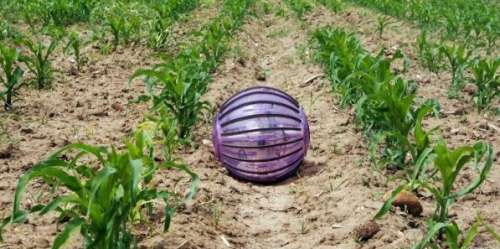 Recently, the Japanese government announced its intention to make its agro-industrial complex 100% robotic by 2020. Despite such a tight deadline, the Japanese may succeed. After all, robotics used in agriculture has long ceased to be science fiction. Most of the existing developments are variations on the theme of an unmanned combine. But there are also very unusual projects.
One of them is the Rosphere robot. The spherical robot was created by engineers from the Polytechnic Institute of Madrid (Spain). The unusual shape and light weight allow the device to move on almost any surface and maneuver between plants without damaging them. The developers themselves call their brainchild a "hamster robot" because of its mobility and appearance, reminiscent of a running ball for a small pet. It has a built-in computer and a lot of sensors that scan the condition of the soil and plants. Thanks to this, the robot does not necessarily need to be controlled, you can simply lower it to the edge of the field, and then collect data.
German engineers are also confident: the fewer people are employed on the land, the more efficiently the entire farm will work. They created a multifunctional machine Agria, which can plant, water and weed. And also, detect pests and destroy them with ultraviolet light. The machine control system is especially interesting. Like many other modern robotic devices, Agria synchronizes with a smartphone via the Internet. This allows you to control the process remotely. However, this is only possible with good Internet coverage, which is not yet available in our country. Experts are hoping for 3G, but its full launch will have to wait several years.
An unusual agricultural robot was developed in Australia. The device was named Ladybird (ladybug) because of its external resemblance to an insect. The peculiarity of this machine is that it is completely autonomous and energy-independent. The entire "back" of the robot is covered with solar batteries, which ensure the smooth operation of the device. Ladybird was created for vegetable growing and can completely replace an agronomist and a worker. The "ladybug" can plant and harvest crops using an advanced manipulator. It is also equipped with a full set of necessary sensors to monitor the growth and health of the crop. Such solar-powered robots are great for work in hot countries.
In 2014, the Massachusetts Institute of Technology (USA) presented its own rating of the main technological events of the year. MIT named the creation of cheap agricultural drones as one of the main achievements of mankind last year. Scientists and researchers considered this event a breakthrough. Drones are already used not only to collect information, but also for more active actions, such as sowing or watering. Let us remind you that not long ago we reported on a project, the authors of which taught a robotic drone to fight weeds using a thermal laser. In our country, there are also projects promoting aerial drones in Ukrainian agriculture.
Recently, the Japanese government announced its intention to make its agro-industrial complex 100% robotic by 2020. Despite such a tight deadline, the Japanese may succeed. After all, robotics used in agriculture has long ceased to be science fiction. Most of the existing developments are variations on the theme of an unmanned combine. But there are also very unusual projects.
One of them is the Rosphere robot. The spherical robot was created by engineers from the Polytechnic Institute of Madrid (Spain). The unusual shape and light weight allow the device to move on almost any surface and maneuver between plants without damaging them. The developers themselves call their brainchild a "hamster robot" because of its mobility and appearance, reminiscent of a running ball for a small pet. It has a built-in computer and a lot of sensors that scan the condition of the soil and plants. Thanks to this, the robot does not necessarily need to be controlled, you can simply lower it to the edge of the field, and then collect data.
German engineers are also confident: the fewer people are employed on the land, the more efficiently the entire farm will work. They created a multifunctional machine Agria, which can plant, water and weed. And also, detect pests and destroy them with ultraviolet light. The machine control system is especially interesting. Like many other modern robotic devices, Agria synchronizes with a smartphone via the Internet. This allows you to control the process remotely. However, this is only possible with good Internet coverage, which is not yet available in our country. Experts are hoping for 3G, but its full launch will have to wait several years.
An unusual agricultural robot was developed in Australia. The device was named Ladybird (ladybug) because of its external resemblance to an insect. The peculiarity of this machine is that it is completely autonomous and energy-independent. The entire "back" of the robot is covered with solar batteries, which ensure the smooth operation of the device. Ladybird was created for vegetable growing and can completely replace an agronomist and a worker. The "ladybug" can plant and harvest crops using an advanced manipulator. It is also equipped with a full set of necessary sensors to monitor the growth and health of the crop. Such solar-powered robots are great for work in hot countries.
In 2014, the Massachusetts Institute of Technology (USA) presented its own rating of the main technological events of the year. MIT named the creation of cheap agricultural drones as one of the main achievements of mankind last year. Scientists and researchers considered this event a breakthrough. Drones are already used not only to collect information, but also for more active actions, such as sowing or watering. Let us remind you that not long ago we reported on a project, the authors of which taught a robotic drone to fight weeds using a thermal laser. In our country, there are also projects promoting aerial drones in Ukrainian agriculture.
 Recently, the Japanese government announced its intention to make its agro-industrial complex 100% robotic by 2020. Despite such a tight deadline, the Japanese may succeed. After all, robotics used in agriculture has long ceased to be science fiction. Most of the existing developments are variations on the theme of an unmanned combine. But there are also very unusual projects.
One of them is the Rosphere robot. The spherical robot was created by engineers from the Polytechnic Institute of Madrid (Spain). The unusual shape and light weight allow the device to move on almost any surface and maneuver between plants without damaging them. The developers themselves call their brainchild a "hamster robot" because of its mobility and appearance, reminiscent of a running ball for a small pet. It has a built-in computer and a lot of sensors that scan the condition of the soil and plants. Thanks to this, the robot does not necessarily need to be controlled, you can simply lower it to the edge of the field, and then collect data.
German engineers are also confident: the fewer people are employed on the land, the more efficiently the entire farm will work. They created a multifunctional machine Agria, which can plant, water and weed. And also, detect pests and destroy them with ultraviolet light. The machine control system is especially interesting. Like many other modern robotic devices, Agria synchronizes with a smartphone via the Internet. This allows you to control the process remotely. However, this is only possible with good Internet coverage, which is not yet available in our country. Experts are hoping for 3G, but its full launch will have to wait several years.
An unusual agricultural robot was developed in Australia. The device was named Ladybird (ladybug) because of its external resemblance to an insect. The peculiarity of this machine is that it is completely autonomous and energy-independent. The entire "back" of the robot is covered with solar batteries, which ensure the smooth operation of the device. Ladybird was created for vegetable growing and can completely replace an agronomist and a worker. The "ladybug" can plant and harvest crops using an advanced manipulator. It is also equipped with a full set of necessary sensors to monitor the growth and health of the crop. Such solar-powered robots are great for work in hot countries.
In 2014, the Massachusetts Institute of Technology (USA) presented its own rating of the main technological events of the year. MIT named the creation of cheap agricultural drones as one of the main achievements of mankind last year. Scientists and researchers considered this event a breakthrough. Drones are already used not only to collect information, but also for more active actions, such as sowing or watering. Let us remind you that not long ago we reported on a project, the authors of which taught a robotic drone to fight weeds using a thermal laser. In our country, there are also projects promoting aerial drones in Ukrainian agriculture.
Recently, the Japanese government announced its intention to make its agro-industrial complex 100% robotic by 2020. Despite such a tight deadline, the Japanese may succeed. After all, robotics used in agriculture has long ceased to be science fiction. Most of the existing developments are variations on the theme of an unmanned combine. But there are also very unusual projects.
One of them is the Rosphere robot. The spherical robot was created by engineers from the Polytechnic Institute of Madrid (Spain). The unusual shape and light weight allow the device to move on almost any surface and maneuver between plants without damaging them. The developers themselves call their brainchild a "hamster robot" because of its mobility and appearance, reminiscent of a running ball for a small pet. It has a built-in computer and a lot of sensors that scan the condition of the soil and plants. Thanks to this, the robot does not necessarily need to be controlled, you can simply lower it to the edge of the field, and then collect data.
German engineers are also confident: the fewer people are employed on the land, the more efficiently the entire farm will work. They created a multifunctional machine Agria, which can plant, water and weed. And also, detect pests and destroy them with ultraviolet light. The machine control system is especially interesting. Like many other modern robotic devices, Agria synchronizes with a smartphone via the Internet. This allows you to control the process remotely. However, this is only possible with good Internet coverage, which is not yet available in our country. Experts are hoping for 3G, but its full launch will have to wait several years.
An unusual agricultural robot was developed in Australia. The device was named Ladybird (ladybug) because of its external resemblance to an insect. The peculiarity of this machine is that it is completely autonomous and energy-independent. The entire "back" of the robot is covered with solar batteries, which ensure the smooth operation of the device. Ladybird was created for vegetable growing and can completely replace an agronomist and a worker. The "ladybug" can plant and harvest crops using an advanced manipulator. It is also equipped with a full set of necessary sensors to monitor the growth and health of the crop. Such solar-powered robots are great for work in hot countries.
In 2014, the Massachusetts Institute of Technology (USA) presented its own rating of the main technological events of the year. MIT named the creation of cheap agricultural drones as one of the main achievements of mankind last year. Scientists and researchers considered this event a breakthrough. Drones are already used not only to collect information, but also for more active actions, such as sowing or watering. Let us remind you that not long ago we reported on a project, the authors of which taught a robotic drone to fight weeds using a thermal laser. In our country, there are also projects promoting aerial drones in Ukrainian agriculture.


